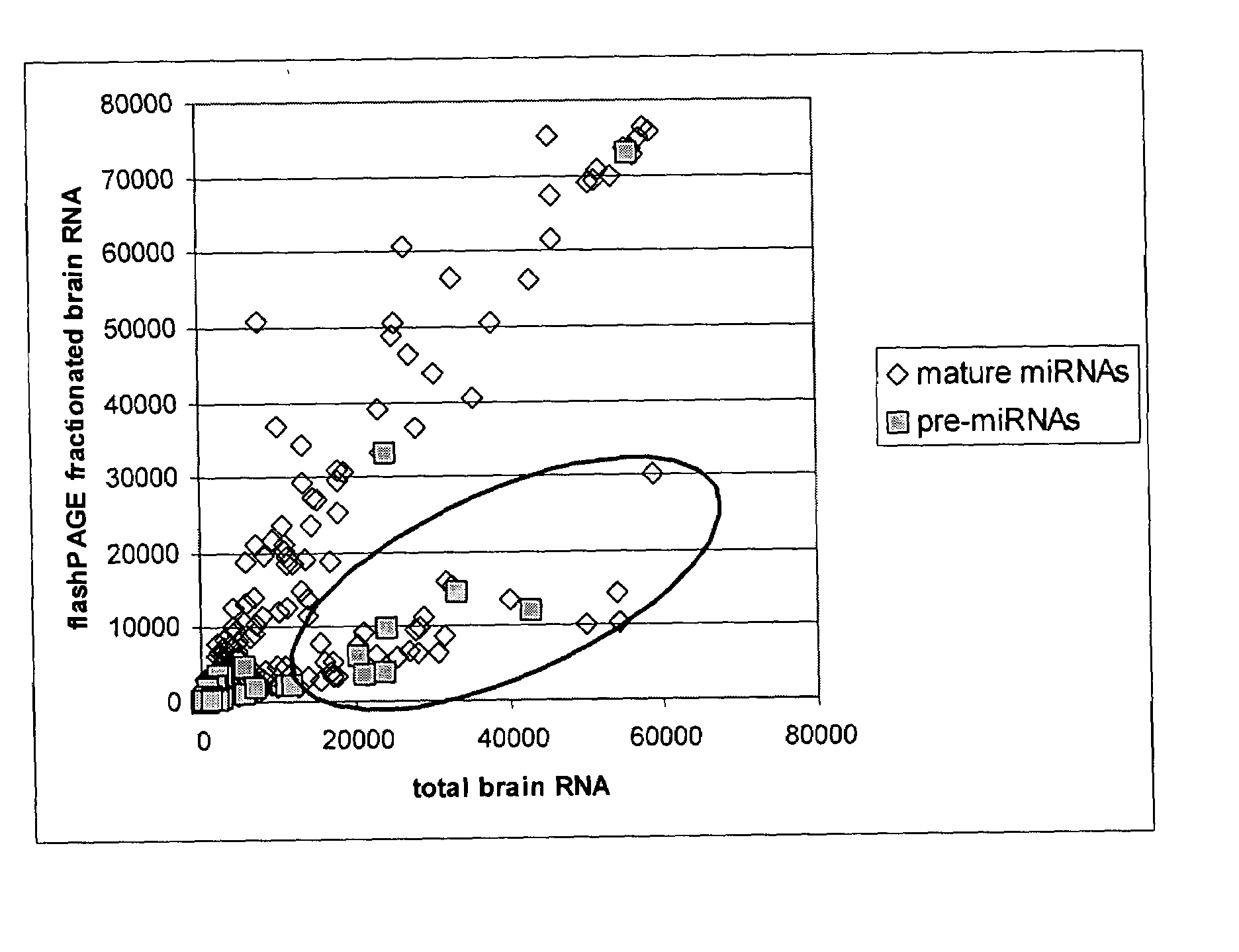Oligonucleotide probes useful for detection and analysis of microRNA precursors
- Summary
- Abstract
- Description
- Claims
- Application Information
AI Technical Summary
Benefits of technology
Problems solved by technology
Method used
Image
Examples
example 1
Detection of Mature miRNA and miRNA Precursors on Microarrays
[0151]Experiment 1a: Mature miRNA probes bind both mature miRNA and longer transcripts, such as miRNA precursors, using oligonucleotide microarray. Total RNA pre-pared from human kidney, lung, and brain (Ambion) was hybridized to an array with and without sample filtering through a flashPAGE Fractionator (Ambion) which removes longer RNA transcripts, such as miRNA precursors, and retains shorter transcripts such as mature miRNA. In FIG. 1, the red oval identifies oligonucleotide probes whose signal is decreased after flashPAGE fractionation, including some oligonucleotide probes designed to target mature miRNA. This unexpected decrease in mature miRNA probe signal after fractionation suggests that longer transcripts, potentially miRNA precursors, are also binding the mature miRNA probes.
[0152]Experiment 1b: miRNA precursor is confirmed to bind mature miRNA probes. We next verified that the longer transcripts binding mature...
example 2
Tissue Specificity of miRNA Precursors as Measured by Northern Blot
[0170]As a first step in validating targets of a set of brain-specific miRNAs and miRNA precursors, we isolated total RNA from brain and other mouse tissues, as well as from murine N2A neuroblastoma and HeLa cells, and performed Northern blots with miRNA-specific and miRNA precursor-specific probes.
[0171]Surprisingly, in the case of miR-138, we observed a band of ˜70-nt corresponding to its precursor, pre-miR-138, which was present in all tissues and cells analyzed (FIG. 3). In contrast, the mature 23-nt miR-138 was detectable only in the cerebrum and cerebellum of adult mice as well as in N2A cells (FIG. 4), suggesting that the ubiquitously expressed precursor is processed into the mature miRNA in a tissue specific manner. Other miRNA like miR-9, miR124a, miR-127, miR-128a and miR228 are pre-sent only as mature forms in all tissues analyzed (FIG. 3).
Methods:
[0172]Isolation of total RNA from cells and mouse tissues a...
example 3
Detection of Pre-miRNAs In Situ Using Dig-Labeled Oligonucleotides
[0175]To further investigate the overall distribution of miR-138 and its precursor, we performed in situ hybridizations with 3′ DIG-labeled LNA oligonucleotide probes on cryo-sections of E17 mouse embryos (FIG. 5A) and adult brain (FIG. 5B). The sequences of the oligonucleotide probes were as follows (capital letters indicate LNA and mC indicates methyl cytosine):
miR-122a:5′-acAaamCacmCatTgtmCacActmCca-3′miR-138:5′-gatTcamCaamCacmCagmCt-3′pre-miR-138-2:5′-ggtAagAggAtgmCgcTgcTcgt-3′
[0176]We observed a strong staining in the central nervous system (CNS) for miR-138 (FIG. 5A, left panel). In particular, miR-138 was primarily localized to Purkinje and granule cells of the cerebellum, but also to most neurons in the hippocampus and to specific regions of the neocortex (FIG. 5A, left panel, and FIG. 6A). This clearly demonstrates that expression of miR-138 is not uniform throughout the brain but restricted to distinct cellu...
PUM
| Property | Measurement | Unit |
|---|---|---|
| Fraction | aaaaa | aaaaa |
| Fraction | aaaaa | aaaaa |
| Fraction | aaaaa | aaaaa |
Abstract
Description
Claims
Application Information
 Login to View More
Login to View More - R&D
- Intellectual Property
- Life Sciences
- Materials
- Tech Scout
- Unparalleled Data Quality
- Higher Quality Content
- 60% Fewer Hallucinations
Browse by: Latest US Patents, China's latest patents, Technical Efficacy Thesaurus, Application Domain, Technology Topic, Popular Technical Reports.
© 2025 PatSnap. All rights reserved.Legal|Privacy policy|Modern Slavery Act Transparency Statement|Sitemap|About US| Contact US: help@patsnap.com



